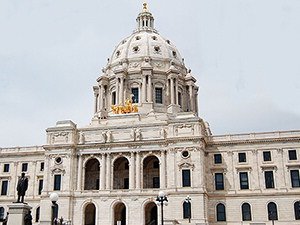Raise your voice this legislative session for a better University

This legislative session, the University of Minnesota is requesting state legislators and Gov. Mark Dayton to fund six capital investment projects, including the renovation of John T. Tate Laboratory of Physics (Tate Laboratory) and Higher Education Asset Preservation and Replacement (HEAPR), which includes projects in Lind Hall, Keller Hall, and Mechanical Engineering. Gaining the support of elected officials for these projects will rely heavily on the advocacy efforts of the College of Science and Engineering affiliates, especially alumni.
The iconic 88-year-old Tate Laboratory is in dire need of renovation to preserve its expanding enrollment capacity, modernize classroom and lab space, and retain its classical architecture. Currently, Tate struggles to serve more than 3,500 students each year and research opportunities are limited by the aging building.
The three College of Science and Engineering HEAPR projects aim to provide better learning environments for students, while extending the lives of the buildings. Specifically, the projects include window replacements, exterior envelope improvements, and electrical and HVAC system upgrades.
All of these projects in the University’s 2014 bonding request are essential as the demand for STEM (science, technology, engineering, and mathematics) education in Minnesota increases. A performance metric in the 2013 state omnibus higher education bill mandated that the University increase the number of students graduating with STEM degrees to help meet Minnesota’s growing need for a highly skilled workforce. About twothirds of U of M graduates build lifelong careers in Minnesota.
Dayton recommends full funding for Tate Laboratory
The University is requesting $232.7 million in this year’s bonding bill, for the six priority projects. On January 15, Governor Dayton introduced his bonding proposal which provides $118.7 million for three University of Minnesota construction projects, including full funding ($56.7 million) for renovations to Tate Laboratory; $12 million to the research laboratory improvement fund, which includes the St. Paul campus aquatic invasive species and bee laboratories; and $10 million to renovate and expand the Crookston campus wellness center, to better serve a growing residential student population and help the campus become a more vibrant regional center.
Dayton’s recommendation also provides $40 million of the $100 million University officials requested for Higher Education Asset Preservation and Replacement (HEAPR), used to maximize and extend the life of facilities that serve students, faculty, and staff system-wide. One in four of the University’s major campus buildings are 70 years old or older, according to capital planning officials. The Twin Cities campus alone has nearly 100 buildings that are more than 50 years old. Many of these buildings require renewal in order to prepare students for successful careers in the 21st century. Renovation of the old part of the Mechanical Engineering Building is among the projects in the University’s HEAPR request.
The University will continue to work with the governor and legislators this session to fully fund the U’s bonding request, including crucial HEAPR projects, which provide renewal funds and help bring buildings up to code for health, safety, and accessibility purposes. The University itself has committed $66.3 million to complement the $232.7 million bonding request.
Your voice matters
In 2011, the personal stories of College of Science and Engineering students, alumni, and faculty helped secure $51.3 million for the Physics and Nanotechnology Building. Through advocacy, you can help the University to improve the education and research experiences for CSE students. Here are some ways:
- Become educated on the projects. Learn more at govrelations.umn.edu/capital-request.
- Take action. Contact your senator and ask him/her to fully support the University’s capital request.
- Share your story about how the University has illuminated your life by visiting the Legislative Action Network at legislative-action.umn.edu.
